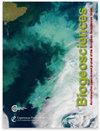从墨西哥玛雅潘考古遗址石笋中的多环芳烃和单糖酸酐推断出过去的火动力学
IF 3.9
2区 地球科学
Q1 ECOLOGY
引用次数: 1
摘要
摘要洞穴石笋含有无机和有机物质,可以用来推断当地和区域古环境条件的过去变化。特定的生物标志物可以用来阐明过去火灾的历史,这些火灾是由气候、区域水文、植被、人类和火灾活动之间的相互作用引起的。采用简单的固液萃取法对碳酸盐粉末样品进行萃取,制备了用于分析16种多环芳烃(PAHs)和3种单糖酐(MAs)的样品。该制备方法只需要少量样品(0.5-1.0 g);GC-MS和LC-HILIC-MS分别测定PAHs和MAs。PAHs的检出限为0.05-2.1 ng, ma的检出限为0.01 - 0.1 ng。我们将该方法应用于来自墨西哥玛雅潘(Yucatán半岛最大的后古典玛雅首都)的Cenote chen Mul的10个约400年历史的石笋样本。我们发现主要ma(左旋葡聚糖)与非烷基化多环芳烃(Σ15)之间存在很强的相关性(r = 0.75, p < 0.05)。我们调查了多环芳烃和MA的多种诊断比率,发现尽管并非所有比率都适用于古火灾指标,但结合多环芳烃和MA的比率是识别不同火灾制度和推断燃烧燃料类型的有前途的工具。在20世纪50年代和60年代,左旋葡聚糖和Σ15concentrations与过去400年的其他时间相比大约翻了一番,这表明在这20年里玛雅岛的火灾活动更频繁。火灾标志的高度集中可能是卡内基研究所考古学家在现场清理土地和探索洞穴的结果。本文章由计算机程序翻译,如有差异,请以英文原文为准。
Past fire dynamics inferred from polycyclic aromatic hydrocarbons and monosaccharide anhydrides in a stalagmite from the archaeological site of Mayapan, Mexico
Abstract. Speleothems (cave stalagmites) contain inorganic and organic substances that can be used to infer past changes in local and regional paleoenvironmental
conditions. Specific biomarkers can be employed to elucidate the history of
past fires, caused by interactions among climate, regional hydrology,
vegetation, humans, and fire activity. We conducted a simple solid–liquid
extraction on pulverised carbonate samples to prepare them for analysis of
16 polycyclic aromatic hydrocarbons (PAHs) and three monosaccharide
anhydrides (MAs). The preparation method requires only small samples
(0.5–1.0 g); PAHs and MAs were measured by GC–MS and LC–HILIC–MS,
respectively. Detection limits range from 0.05–2.1 ng for PAHs and
0.01–0.1 ng for MAs. We applied the method to 10 samples from a
∼ 400-year-old stalagmite from Cenote Ch'en Mul, at Mayapan
(Mexico), the largest Postclassic Maya capital of the Yucatán Peninsula. We found a strong correlation (r = 0.75, p < 0.05) between the major
MA (levoglucosan) and non-alkylated PAHs (Σ15). We investigated
multiple diagnostic PAH and MA ratios and found that although not all were
applicable as paleo-fire proxies, ratios that combine PAHs with MAs are
promising tools for identifying different fire regimes and inferring the
type of fuel burned. In the 1950s and 1960s, levoglucosan and Σ15
concentrations roughly doubled compared to other times in the last 400 years, suggesting greater fire activity at Mayapan during these two decades.
The higher concentrations of fire markers may have been a consequence of
land clearance at the site and exploration of the cave by Carnegie
Institution archaeologists.
求助全文
通过发布文献求助,成功后即可免费获取论文全文。
去求助
来源期刊

Biogeosciences
环境科学-地球科学综合
CiteScore
8.60
自引率
8.20%
发文量
258
审稿时长
4.2 months
期刊介绍:
Biogeosciences (BG) is an international scientific journal dedicated to the publication and discussion of research articles, short communications and review papers on all aspects of the interactions between the biological, chemical and physical processes in terrestrial or extraterrestrial life with the geosphere, hydrosphere and atmosphere. The objective of the journal is to cut across the boundaries of established sciences and achieve an interdisciplinary view of these interactions. Experimental, conceptual and modelling approaches are welcome.
 求助内容:
求助内容: 应助结果提醒方式:
应助结果提醒方式:


